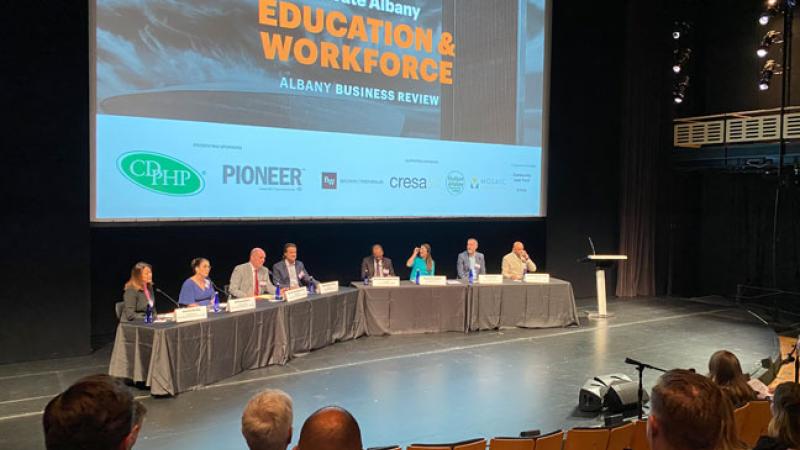July 6, 2023

Recently, the Albany Business Review hosted the Elevate Albany: Education and Workforce Development Summit at Rensselaer Polytechnic Institute’s Curtis R. Priem Experimental Media and Performing Arts Center (EMPAC). The lively conversation around the tight labor pool in the Capital Region and how to address it, in the name of economic growth, kept the audience captive.
Rensselaer President Martin A. Schmidt ’81, Ph.D., participated, along with David William Davis, president of the NSH USA Corporation; Annmarie Lanesey, founder and CEO of CanCode Communities and president of Greane Tree Technology; Jeanette M. Moy, commissioner of the New York State Office of General Services; Roger A. Ramsammy, Ph.D., president of Hudson Valley Community College; Havidan Rodriguez, Ph.D., president of the University at Albany, SUNY; Kathleen Skeals, superintendent of North Colonie Central Schools; and David Wojeski, founding partner of Wojeski & Company CPAs, P.C.
Participants cited potential solutions to the tight labor pool already being enacted and ideas for more solutions were discussed. Schmidt pointed out the importance of focusing on the pipeline of talent, noting RPI’s ongoing outreach activities to high school students across the state. He also pointed out RPI’s partnership with HVCC to expose HVCC students to opportunities within the semiconductor industry through RPI, as well as provide a pipeline to continue their studies should they be interested in a degree from RPI. Rodriguez said that partnerships were vital to meet workforce needs, and mentioned a bachelor’s and master’s degree program developed between SUNY Albany and HVCC to meet the nursing shortage. Ramsammy pointed out that students should be exposed to opportunities starting in elementary schools. Skeals said her school district has innovation spaces in all of the elementary schools.
Also discussed was the concept of the “invisible workforce,” which refers to those who are able to work but are not exposed to the right opportunities and are otherwise overlooked. Although some students may not necessarily excel in the traditional classroom, some respond best to hands-on, experiential learning, and those opportunities need to reach everyone, not just those with straight A’s. Davis pointed out programs in other countries that train immigrants to meet workforce needs.
As industry, nonprofit organizations, and government work together to develop the workforce, attention must also be paid to infrastructure needs such as housing and childcare. Overall, the region’s accessibility and affordability are attractive to workers and opportunity abounds, but collaboration among sectors will be critical to the region’s economic growth.